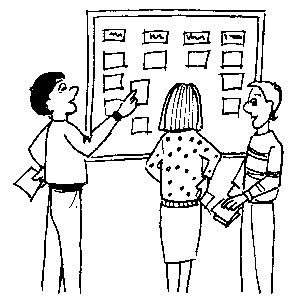Information & Design
Designing for humans
Designing for humans

Download ‘printer-friendly’ PDF version (File size: 15 KB)
Affinity Diagramming is a very simple but powerful technique for grouping and understanding information.
In particular, affinity diagramming provides a good way to identify and analyze issues. There are several variations of the technique.
Use affinity diagramming in a workshop environment when you want participants to work together identifying, grouping and discussing issues.
You can also use affinity diagramming when you have a large amount of information – for example, at the end of a contextual enquiry, when you may have hundreds or even thousands of individual notes.
Affinity diagramming simply consists of placing related items together.
Although this can be done electronically for very small sets of data (using a word processor or spreadsheet program), it is better to work with paper. In group situations, always use paper.
If you have a pre-existing set of information, you can print these on labels or card, or print on paper and guillotine to a convenient size.
In a group situation, begin by handing out Post-It(tm) notes.
Ask participants to write one issue on each note.
Give participants some minutes for this activity, but ask them to stop when a large majority of participants have stopped.
Get all participants to gather at a vertical surface suitable for Post-It notes. Windows are appropriate.
Encourage participants to place notes, one at a time, on the surface. As each note is placed, other participants may add similar notes in close proximity.
Depending on the amount of time, the information being analyzed, and on group dynamics (and patience) it may be worth spending some additional time considering and rearranging the groups.
When all notes have been placed and grouped, you can optionally name each group.
If there are more than 8 people, gathering around a common area may not be convenient. In this case, you can handle all the note-placing yourself-get one note from each person in turn; all participants can then pass you any similar or related notes. This is not as satisfactory as having the group work together, since it is difficult to keep everyone focused on the task.
Affinity diagramming is best used if the work can be followed up quickly. For example, affinity diagramming of issues can lead into discussion of methods to address the issues.